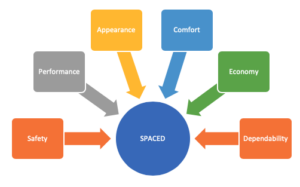Relationship Selling: Measuring Sales Activities Generates More Sales
Guest writer Floyd Jerkins continues his series on Relationship Selling with this week’s blog post: Measuring Sales Activities Generates More Sales.
Whether you have two or 200 salespeople, just talking to more people isn’t the best way to improve closing ratios. Measuring their sales activities generates more sales and allows you to know exactly where they need coaching.
Are You Using a Sales System?
Before we get too deep, let’s make sure you and I are on the same page. I believe you have to be using a sales process and a sales system. The key is to know where you are at in the sales cycle and to know where the customer is at in the buying cycle. Without utilizing these tools, you guess and wonder let alone waste valuable time.
Stop here and check out a couple previous articles of mine on the Steps to the Sale and Relationship Selling: Face to Face & Write Ups, and How to Measure Sales Success. It doesn’t matter that you are using different terms. What is vital is that you are working a sales process with your team and that each salesperson logs into a CRM.
Measuring Effectiveness is the Key to Increasing Sales
Why are salespeople having problems closing sales? Measuring what their sales activities are between the time they first talk with a customer until they price or close the deal will tell you where adjustments can be made.
Will most strategies work with all the customers all the time? Heavens no. Will they work with most of the customers, most of the time? Yes. Sure, the market is tough, prices are high, and the world is turning over and over, so we want to use real-time behavioral analysis to chart a path to more success.
Through analysis for example, you see they are shortchanging the qualifying process. They are getting into the close and realize they don’t know how much down payment the customer has, or that they had a trade-in, or they are not the decision-maker or myriad other things that can derail the close based on your kind of product and business. How are they building value of your product and your business if they don’t know this early on in the sales process?
Building value happens throughout the sales process, not just in the close.
If it all comes down to price, then just post your best price by a kiosk and fire all your salespeople. You improve a salespersons effectiveness not by talking to more customers but by doing a better job with those they work with.
What if you were able to improve your salespeople’s closing ratio from 10% to 15%, how much more money will you make?
Learning to ask better questions isn’t normal for many salespeople. Letting the customer control the tempo of the discussions happens. A good salesperson knows how to navigate the conversation to get out of it what they want, vs. just giving the customer what they want. Asking for the order too prematurely or pricing too quickly delays the buying process for the customer, takes more time to make the sale, and typically makes less margin.
An Exercise to Learn By
If your salespeople are closing deals at anything under 25%, then they are not exempt from a sales manager closely monitoring their sales behaviors. I’d want to see, feel and touch what’s happening in real-time.
Exercise Preparation
My goal here is for you to outline a complete customer profile to use in a roleplay. I’m not saying be an easy customer, but be realistic. Be the kind of customer that your salesperson encounters most of the time.
Include what the customer is looking for and why. List how they plan to pay for it and why they are shopping at your business, if they are married or not, and anything else that describes their buying motivations. List what they like the most and least about what they currently own and how much they paid for it. Did they finance it or pay cash?
Roleplay
Roleplay with your salesperson using the outline as your guide. Start with the introduction between the customer and the salesperson. Have the salesperson show you how they handle the first few steps to the sale. See how “effective” your salesperson is at finding out all that information in a casual, professional and sales focused manner.
Results
If your salesperson doesn’t like roleplaying because it’s not real, ok, you have a problem. If they do the roleplay but then make comments like, well, in a real situation, I wouldn’t say it like that.
You have a problem.
The start of the sale should make the customer feel at ease. Does the salesperson make a good introduction? The next step in the sales process is discovering or qualifying the customer. This is where they ask several questions and learn how to build value in your products and services that matter to the customer. Do they handle this well or shortchange the process?
A Coach Calls the Plays
In any professional sport team, the coach calls a play. They know the stats how each player performs and under certain conditions make changes. When a sales manager measures sales activities they know the stats of how each player performs. They know what plays to call and it reaps more sales.
Sales teams who are only measured by total units sold or just dollar volume, are leaving thousands of sales and dollars on the table. Measuring their sales activities generates more sales and allows you to know exactly where they need coaching.


